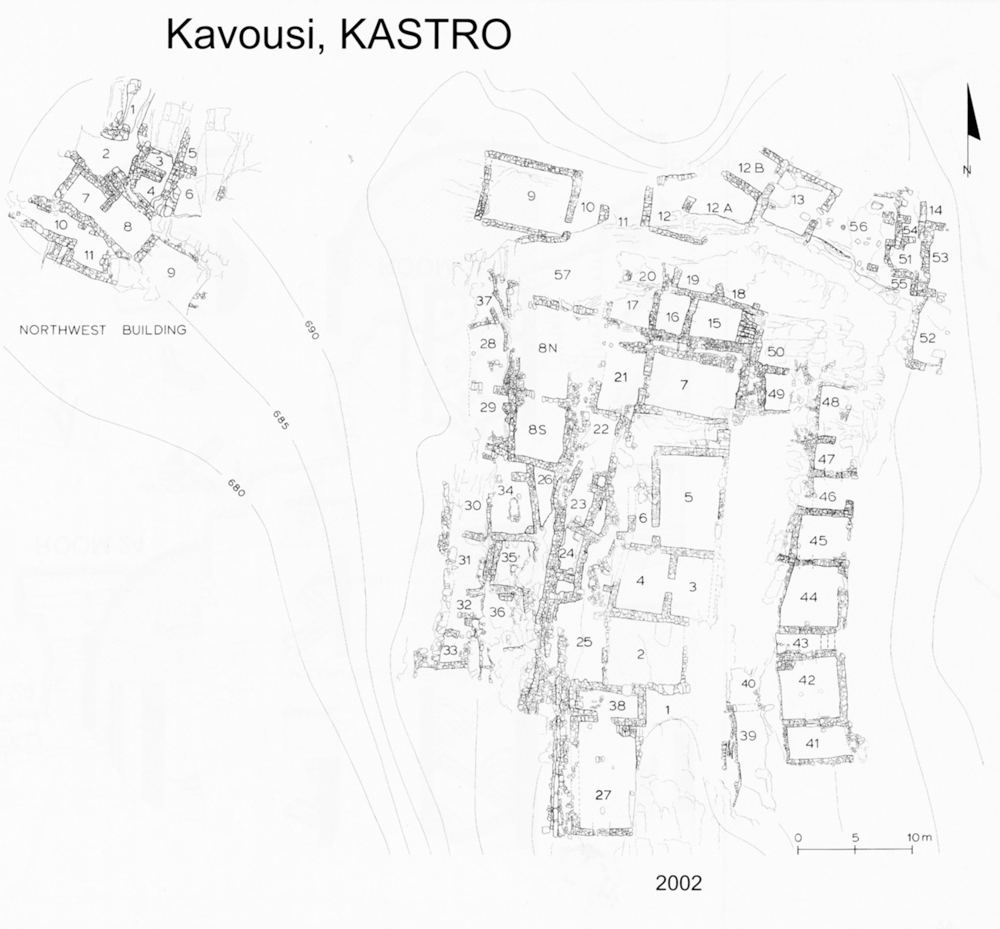The Early Iron Age (EIA) settlement of Kastro is located on a high rocky peak (713 m above sea level) to the south of the village of Kavousi, approximately 1 km to the east of Vronda.

The site was first explored by Harriet Boyd in 1900 and later excavated as part of the Kavousi Project (1987–1992), under the direction of William Coulson, Leslie Day, and Geraldine Gesell.
The settlement was founded at the beginning of Late Minoan IIIC (ca. 1200 B.C., slightly earlier than Vronda) and was inhabited continuously until the Orientalizing (O) period (mid/end 7th c. B.C.) after which it was abandoned. This long-term occupation provides important information regarding the development and growth of an EIA community, illustrating for example changes in architecture, settlement organization, and socio-political structure.

Although the site has not been fully excavated, the majority of buildings at Kastro in all phases belong to typical houses of two, three, or four rooms, which were agglomerative in plan and built upon terraces; these houses were also organized in clusters of neighborhoods, which were separated by streets and courtyards. Starting in the Protogeometric (PG) period and continuing on a wider scale in the Late Geometric (LG), the buildings became more regular (and axial) in plan and with larger, more consistent room sizes, and they were constructed on more extensive terraces, which often covered or filled in houses of earlier date. For example, PG Building G (Rooms 21–24), which consisted of three rooms and a courtyard, was later filled in to create an expanded terrace. As a result, much of the visible architecture dates to the Late Geometric period, including Building L (Rooms 57, 8N+S, 34, 35) on the western slope, which represents a four-room house with a courtyard, and Building A (Rooms 41–45) on the eastern slope, which may represent two separate adjacent houses built on the same terrace. Late Geometric Building H (Rooms 1, 27, 27S, 38) is larger than other buildings on the site (and with more elaborate terracing), and it is located on the summit of the hill, indicating that it may have served a special function such as a “ruler’s dwelling”; a stone kernos was also found in this structure. As evident in these structures (as well as in the Northwest Building, which shows evidence of all occupation phases), the Early Orientalizing (EO)/Orientalizing period is characterized by a gradual reduction of settlement and house size, represented by the blocking of doorways and abandonment of certain rooms.
There is a dirt road to Kastro leading from the eastern end of the village of Kavousi (signed only at the beginning), which leads nearly to the site (~45 minutes driving); otherwise, the site can be accessed on foot from a paved path (kalderimi), which begins at the end of the road to Vronda (~30 minutes). An alternate foot path (Mesonas Gorge) begins south of Azoria and eventually connects with the dirt/car road. The site is unguarded and open with informational signs.


Slide show from left to right (click on each photo to enlarge): two images of the excavation in progress.
Selected References
Boyd, H.A. 1901. “Excavations at Kavousi, Crete, in 1900,” AJA 5, pp. 125–157. DOI: 10.2307/496766.
Coulson, W.D.E., D.C. Haggis, M.S. Mook, and J.L. Tobin. 1997. “Excavations on the Kastro at Kavousi. An Architectural Overview,” Hesperia 66, pp. 315–390. DOI: 10.2307/148394.
Gesell, G.C., L.P. Day, and W.D.E. Coulson. 1985. “Kavousi, 1982–1983: The Kastro,” Hesperia 54, pp. 327–355. DOI: 10.2307/147919.
———. 1988. “Excavations at Kavousi, Crete, 1987,” Hesperia 57, pp. 279–301. DOI: 10.2307/148100.
———. 1995. “Excavations at Kavousi, Crete, 1989 and 1990,” Hesperia 64, pp. 67–120. DOI: 10.2307/148260.
Gesell, G.C., W.D.E. Coulson, and L.P. Day. 1991. “Excavations at Kavousi, Crete, 1988,” Hesperia 60, pp. 145–177. DOI: 10.2307/148085.
Mook, M.S. 2004. “From Foundation to Abandonment: New Ceramic Phasing for the Late Bronze Age and Early Iron Age on the Kastro at Kavousi,” in Crete beyond the Palaces: Proceedings of the Crete 2000 Conference (Prehistory Monographs 10), L.P. Day, M.S. Mook, and J.D. Muhly, eds., Philadelphia, pp. 163–180.
———. 2011. “The Settlement on the Kastro at Kavousi in the Late Geometric Period,” in The “Dark Ages” Revisited. Acts of an International Symposium in Memory of William D.E. Coulson, University of Thessaly, Volos, 14-17 June, 2007, A. Mazarakis Ainian, ed., Volos, pp. 477–488.
Mook, M.S., and W.D.E. Coulson. 1997. “Late Minoan IIIC Pottery from the Kastro at Kavousi,” in Late Minoan III Pottery. Chronology and Terminology. Acts of a Meeting Held at the Danish Institute at Athens, August 12-14, 1994 (Monographs of the Danish Institute at Athens 1), E. Hallager and B.P. Hallager, eds., Athens, pp. 337–365.
